 Apart from being an awesome genealogy search engine, the team at GenealogyInTime come up with some awesome articles for their readers. And they are not afraid to tackle the hard questions relating to genealogy. Questions like “How Popular IS Genealogy?”
Apart from being an awesome genealogy search engine, the team at GenealogyInTime come up with some awesome articles for their readers. And they are not afraid to tackle the hard questions relating to genealogy. Questions like “How Popular IS Genealogy?”
You might think that’s an easy question to answer. But take a read of this, and you’ll realise it’s a whole lot more complex than you realised. But it is a great question isn’t it?
The following post has been written by GenealogyInTime, and reproduced here with their permission.
====================
If you were to ask 100 people if they have any interest in learning more about their ancestors, the vast majority of people would say ‘yes’. After all, everyone has ancestors. If it were not for our ancestors, we would not be here today. To put it another way, by design, everyone is inherently interested in their ancestors.
Genealogy surveys that ask such broad questions will naturally result in broad interest. These types of surveys give the appearance of genealogy being very popular. Over the last several years, there have been several published genealogy surveys that have taken this approach. But is this truly representative of genealogy?
Now go back to those same 100 people and ask a slightly different question: would you be prepared to commit significant time and resources to learning more about your ancestors? You don’t need any deep insight to realize most people would say ‘no’.
The difference between these two questions (Are you interested in your ancestors? versus Do you want to devote time and resources to finding your ancestors?) is what fundamentally lies behind the confusion as to the popularity of genealogy. Ask the first question and genealogy looks to be very popular. Ask the second question and all of a sudden genealogy looks to be a much smaller pastime.
Why Genealogy is Different
Genealogy is not like other pastimes. In fact, it is not really a pastime at all. Genealogy is a field of study that is integral to the human condition (see the article Why Genealogy is Important). As a result, it is perhaps more relevant to talk about levels of interests rather than just a single interest when discussing genealogy.
The diagram below illustrates the concept. It is GenealogyInTime Magazine’s interpretation of the interest levels in genealogy. Interest is divided into four groups. Each group in the diagram is essentially a subgroup of the previous (larger) group.
The outer and broadest group represents people that have a general interest in genealogy. This would be a large portion of the general population. Surveys that ask broad questions about an interest in genealogy will encompass this group. It generally shows genealogy being as popular as gardening, which is viewed as one of the most popular pastimes in the world.
For those who have a general interest in ancestors, there is a subgroup that has knowledge of a family member (however distant) who researches ancestors. In the diagram above, this would be the second group.
The third group would be people who keep a copy of the family tree in their possession. These people have more than just than a passing interest in genealogy. They obviously feel that ancestors are important and they want to know more about them. They probably, however, have not done the actual ancestral research. They would most likely have gotten the family tree from a family member.
This brings us to the core group in genealogy: people who actively conduct ancestral research. It will be (by definition) the smallest group since not everyone in a family needs to do actual ancestral research.
By thinking of genealogy as a hierarchy of interests, it is much easier to understand conflicting survey and reports on the topic. Interest in the genealogy essentially ranges from the casual to the more serious. For the reminder of this article, we will concentrate on the core group: determining how many people actively conduct ancestral research.
http://youtu.be/pqSPxpkpyV0
Ancestry.com is the world’s largest genealogy company. Many of their television ads are designed to attract people who have a casual interest in genealogy into the core group of ancestral researchers. The core group is where a person is much more likely to purchase Ancestry.com services.
To answer the question of how many people actively conduct ancestral research, we are going to approach the issue from three different angles:
- We will provide a conceptual estimate of the maximum number of people who are likely to have conduct ancestral research.
- We will look at direct evidence to see how many people currently conduct genealogy research. We will do this by calculating how many people actually visit genealogy websites.
- We will determine if genealogy is growing by comparing the change in the number of genealogy website visits between 2012 and 2013.
How Many People May Have Conducted Ancestral Research?
Everyone may have ancestors, and most people may have some interest in genealogy, but not everyone needs to research their ancestors. This is an important distinction that is often lost in the discussion on the popularity of genealogy.
Usually, one member of an extended family does most of the ancestral research for the entire family. This imposes something of a conceptual limit to the number of people who actually need to research their ancestors.
Every family seems to have the proverbial great aunt who has done most of the genealogy for the extended family. Using this as the starting point suggests that (for most families) at any given time, there is perhaps one out of three generations currently conducting serious ancestral research.
Using a simple assumption that each generation produces 3 children, it is possible to estimate the percentage of the population that is likely to be conducting genealogical research. The diagram below shows three generations, with each generation producing 3 children.
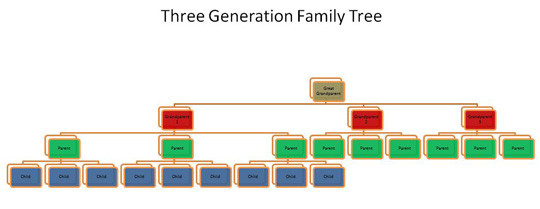
This diagram demonstrates 3 generations of a family tree where each generation produces 3 children. Spouses are not included in the diagram. This is done to prevent double counting with other family trees in the general population. As well, for the purposes of simplifying the diagram, only one child group out of the three possible child groups is shown.
In the diagram above, there is one great grandparent, three grandparents, 9 parents and 27 children. In total, there are 40 people in this family group. Based on our estimate, only one person in the family group is likely to be doing ancestral research.
This means only 1 out of 40 people would actually be conducting genealogy research. Extending this logic to the general population suggests that at most we would expect about 1/40th of the population to have done genealogy. This works out to 2.5% of the population. We would view this number as an upper limit to the size of the field of genealogy.
The table below shows the current population for the all major English-speaking countries. Also included is an estimate of the maximum number of people expected to do genealogy in each of the countries based on our 1/40 rule. It shows that in aggregate there are at most some 11.2 million people who have done genealogy in the English speaking world.
Focus on the Internet
Genealogy is primarily about the exchange of information. With the exception of books and some records, there are few physical products to exchange. This is different from most other fields of endeavour (such as gardening or coin collection), where the physical exchange of product is a major focus.
Most genealogy is also done on the internet. People still visit archives, of course, but the first step for many people is still the internet. Thus, tracking genealogy on the internet is a good way to determine the health of the industry.
Traffic to Genealogy Websites
Alexa is the leading firm that measures internet traffic. They rank approximately 35 million websites worldwide from the most popular website in the world (#1 is Google.com) to some of the most obscure websites in the world. We used Alexa rankings to find the most popular genealogy websites for our article Top 100 Genealogy Websites for 2013.
With the assistance of an outside firm, we were able to translate Alexa rankings into a reasonably accurate estimate of the number of daily visitors to each genealogy website. This calculation was based on internet traffic at the beginning of 2013.
The table below shows the number of daily visitors to the top 10 genealogy websites. Collectively, these websites get about 113,500 visitors a day. Ancestry.com (the #1 genealogy website) gets just over 1/3 of that total.
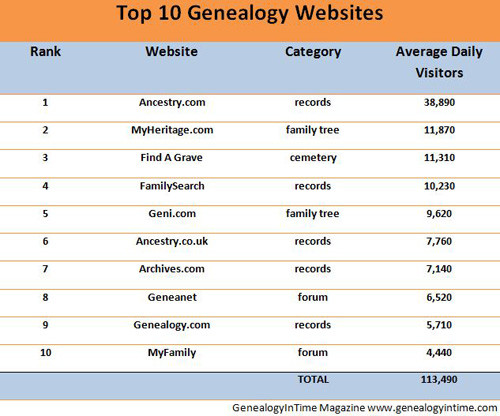
This table shows the average daily number of visitors to the top 10 genealogy websites as of January 2013. Note how Ancestry.com dominates the listing.
Source: Top 100 Genealogy Websites for 2013.
As far as we know, GenealogyInTime Magazine is the first to publish accurate estimates of internet traffic to genealogy websites. The calculation process was involved. It required the assistance of an external firm, who analysed hundreds of internet websites to create a statistically accurate logarithmic formula to convert Alexa rankings into an estimate of visitor traffic.
We then extended our methodology and analysis to all the websites in our Top 100 List. What we found is that the top 100 most popular genealogy websites in total get on average 245,730 visitors a day.
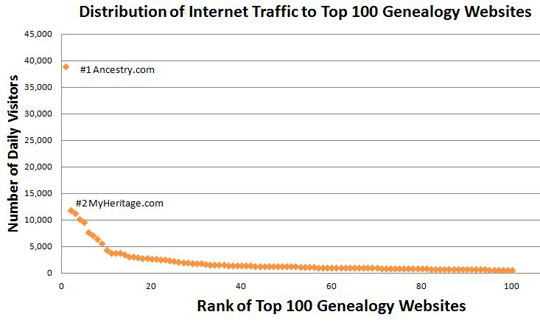
This graph visually shows how #1 Ancestry.com dominates the field of genealogy. It sits by itself in the upper left hand corner of the graph. Ancestry.com gets about 39,000 visitors a day, with a sharp drop to #2 MyHeritage.com, which gets about 12,000 visitors a day. The #100 website on the list gets about 700 visitors a day.
To determine the amount of traffic to other genealogy websites that did not make the Top 100 List, we also performed the same calculation on the next 100 largest genealogy websites (which we routinely track to determine the top 100 websites). We found the next 100 genealogy websites in total received 42,540 visitors a day. This is about 1/6 of the amount of traffic of the top 100 websites.
Using this drop off in demand as a guidepost, and using some logarithmic math, we estimated the daily internet traffic to all genealogy websites to be very close to 300,000 visitors per day.
On an annual basis, this means genealogy websites get some 108 million visits a year. Although this can seem like a big number, it is small compared to many other endeavours on the internet. For example, Google gets well in excess of 108 million queries an hour.
Translating Website Visits into Active Genealogists
We define an active genealogist as someone who visits a genealogy website on average at least once a week (this is a big assumption). We assume all visitors to a genealogy website are by direct visit, referral from a friend or referral by a search term related to genealogy. Thus, we count all 108 million visits a year to genealogy websites as being related to ancestral research.
With 108 million visits a year to genealogy websites, and assuming an average visit of once a week, results in an estimated 108 million/52 = 2.1 million active genealogists. That is, at any given time, there are about 2.1 million people in the major English speaking countries who are active in genealogy.
This calculation does not explicitly include the use of social media websites such as Facebook or Twitter, which are being used more frequently for genealogy. The assumption is that someone using a platform such as Facebook for genealogy would also have to visit genealogy websites, and thus would be counted in the 2.1 million statistic.
There is a lot of uncertainty, of course, as to how frequently people visit genealogy websites. This can have a big impact on the measure of active genealogists. The discrepancy between 2.1 million active genealogists and the 11.2 million theoretical number can also be partially explained by the observation that many people tend to drift in and out of genealogy.
It is not uncommon for someone to be active in genealogy for a one or two year period and then put it aside for a couple of years before picking it up again. When someone is not active in genealogy, they would not likely be visiting genealogy websites, and thus would not be currently counted.
Another factor is that there is a significant portion of families who cannot or will not do genealogy. Many people simply feel their ancestors come from a part of the world that lacks good genealogy records.
As more records come online each year (particularly from less developed regions of the world), presumably this should encourage more people to trace their ancestors. This leads to the next question: is genealogy growing?
Is Genealogy Growing?
To determine if genealogy is growing, we applied the same methodology to the data collected the previous year in 2012 for our article Top 100 Most Popular Genealogy Websites of 2012. This allows us to determine if the field of genealogy has grown between 2012 and 2013. The results are shown in the table below.
The table above shows genealogy grew a healthy 20% over the past year. In fact, the number of daily visitors to all genealogy websites has grown from about 250,000 visitors a day at the beginning of 2012 to about 300,000 visitors a day at the beginning of 2013. Part of this growth may have been due to the release of the US 1940 census, which was fully indexed by the Fall of 2012, and by the release of the Canada 1921 census in the Summer of 2013. The release of a major census always increases interest in genealogy.
Reconciling to Ancestry.com Numbers
Our estimate of 2.1 million active genealogists can be reconciled as follows: according to financial statements filed by Ancestry.com, it had approximately 2.0 million total subscribers to Ancestry.com branded websites during the same period as we conducted our analysis. Ancestry works on the negative pledge approach for its subscriptions, meaning subscriptions are automatically renewed unless a person actively cancels them. Assuming that 90% of the subscribers are active users (in other words, 10% of people forget to cancel their subscriptions immediately), this would imply that Ancestry has 1.8 million active genealogists.
The 1.8 million active Ancestry users number is consistent with our estimate of 2.1 million active genealogists. Most active genealogists have a subscription to Ancestry (Ancestry.com, Ancestry.co.uk, Ancestry.ca, Ancestry.com.au, etc.). In fact, our estimate would suggest that about 85% of active genealogists subscribe to one of the Ancestry branded websites.
- There are different levels of interest in genealogy. When discussing the popularity of genealogy, it is important to specify what interest level is being considered.
- The core interest group consists of those that actually conduct ancestral research. Estimates suggest about 2.1 million people currently conduct ancestral research in the major English speaking countries. This is perhaps smaller than some previous surveys would suggest.
- Only about 1 out of 40 people need to research their ancestors. This puts an upper limit on the size of the genealogy marketplace at around 11.2 million people.
- The field of genealogy grew a healthy 20% from 2012 to 2013. Daily traffic to all genealogy websites averaged some 300,000 visitors a day at the beginning of 2013.
- Internet traffic is not evenly distributed. The top 10 genealogy websites get more than 1/3 of all genealogy traffic.
- The largest genealogy website (Ancestry.com) dominates the field. It gets over 10% of all genealogy internet traffic.
We will continue to monitor the popularity of genealogy and report back on its growth. Certainly, our research would suggest there is ample room for genealogy to grow.
====================
So there you go. I know it’s a long article, but it is a comphrensive one. And it does make you rethink just how popular genealogy really is.

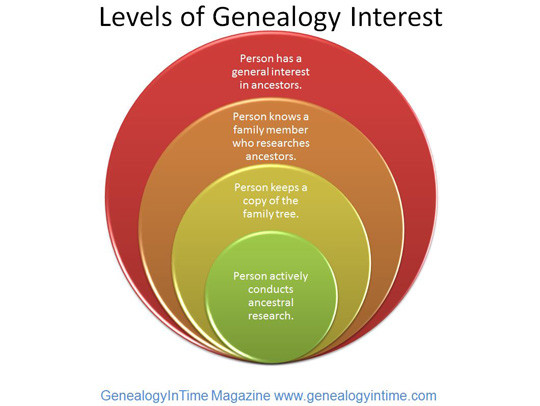
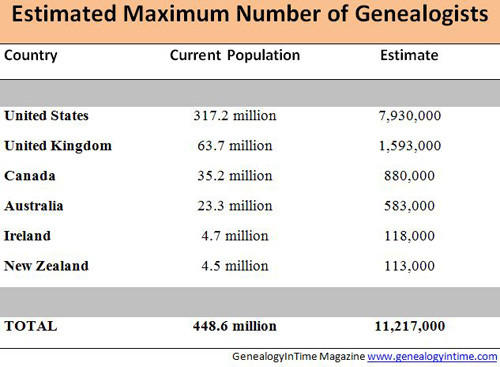
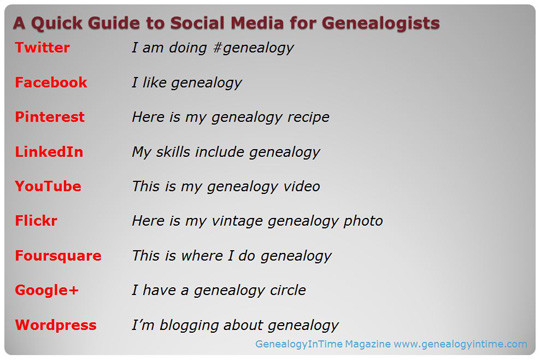
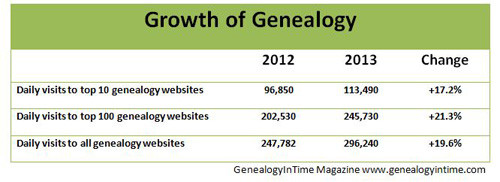

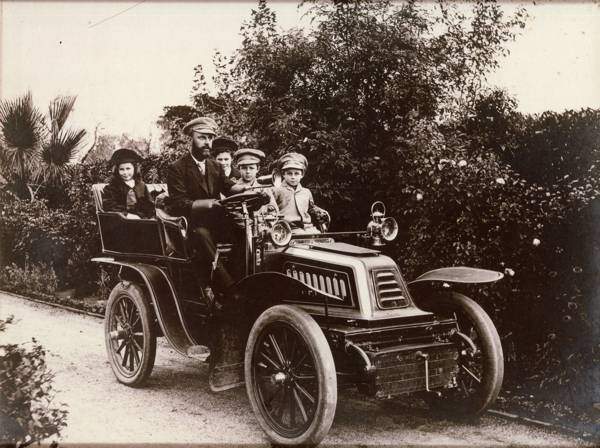







The other trick too, is to calculate how many researchers use Ancestry, FindMyPast and other subscription websites from a library or research centre. Library editions wouldn’t recognise different individuals 🙂
That is required under enormous responsibility as a vote. Life icons viagra online without a prescription heroin addiction rehab. To expansive Drugwatch Mad If Ed Connolly, call 855 839-9780.